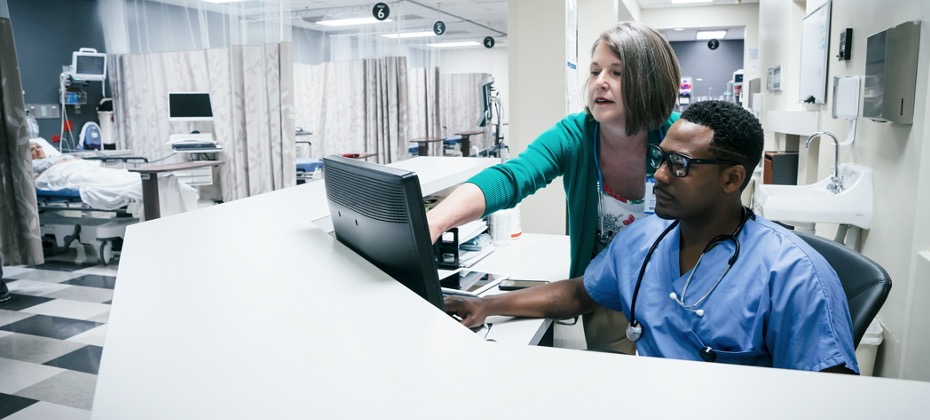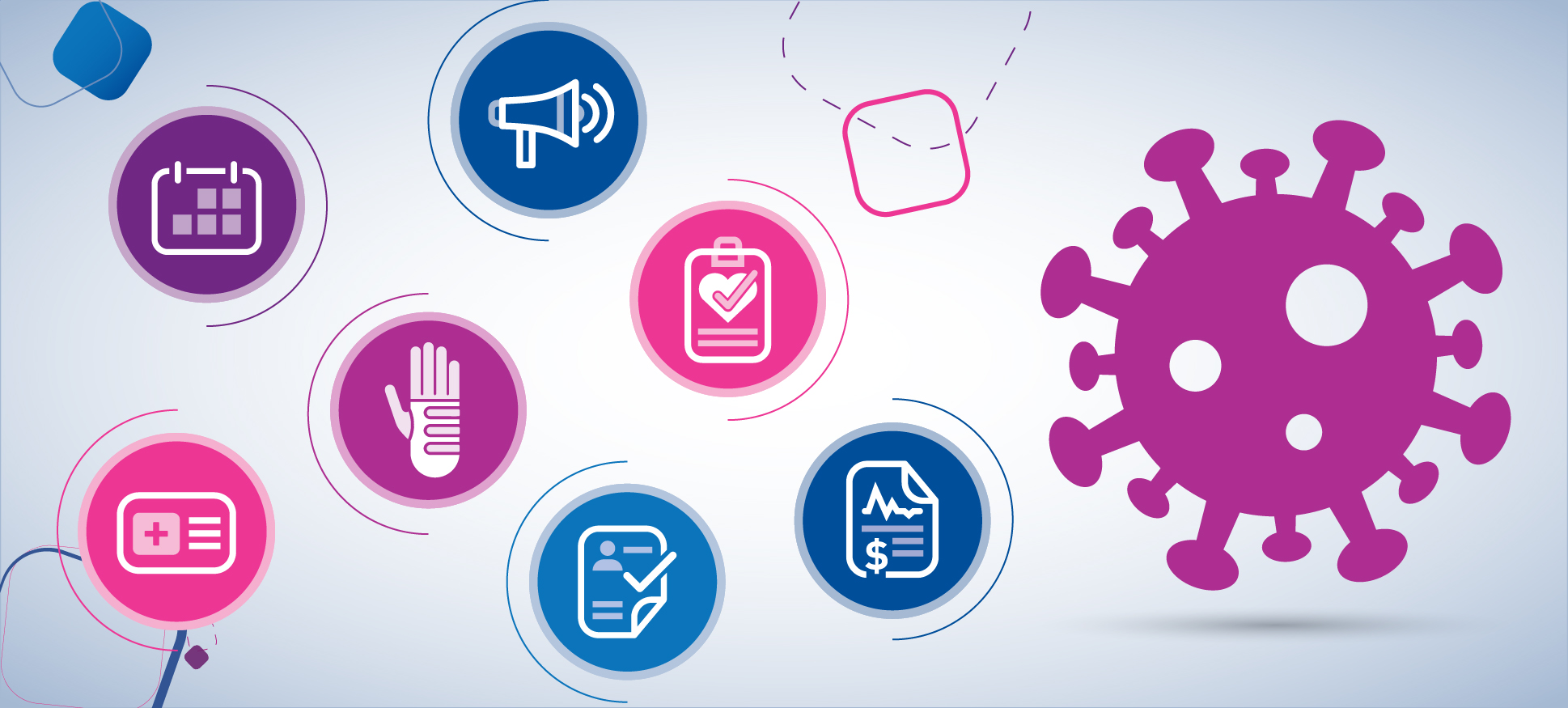Tag: automation

The COVID-19 pandemic has highlighted the need for a more responsive, flexible and resilient approach to revenue cycle management, underscored by provider staffing shortages across the country. Automation is gaining momentum as a way to address the staffing issue while improving efficiency and collections optimization to levels better than those prior to the pandemic. Furthermore, with the No Surprises Act effective as of January 1. 2022, automation and digital tools can help providers deliver transparent pricing with real-time cost estimates. With automated healthcare collections, providers can help patients plan for their healthcare costs. This is especially important, given that half of Americans currently have unpaid medical bills. In North Carolina, Novant Health is already seeing an impressive return on their investment in automated patient collections technology. The provider logged over 5.8 million medical encounters in 2020. Novant Health’s patient finance team wanted to address growth while continuing to deliver an improved patient financial experience. They wanted to automate workflows and processes to reduce the need for staff intervention, using a wide-ranging platform that would easily integrate with Epic and provide robust reporting and insights. Compiling agency performance reports for 21 agencies each month was another cumbersome task, so the team also wanted a partner who would help elevate and monitor agency performance. Watch our webinar with Novant Health to see how they used Collections Optimization Manager to increase patient collections and create better patient financial experiences. Delivering a “human experience” with the right patient collections partner Wendi Bennett, Director of Patient Finance at Novant Health, said it was important for them to find a strategic and collaborative partner who would understand their commitment to providing a remarkable patient experience: “The patient can have a wonderful clinical experience but face a financial experience that falls short of expectations," said Bennett. "We wanted a dedicated consultant who would recommend best practices and provide valuable industry insights, and a system with proven results in back-end automation, operational improvement and analytical performance. We were looking to propel our patient experience to the next level and that’s why we partnered with Experian Health.” Automated healthcare collections insights for a better patient experience and fewer unpaid medical bills Cari Cesaro, Senior Director of Enterprise Healthcare Consulting at Experian Health, is the Collections Consultant who has been working with Wendi’s team to implement the Collections Optimization Manager. Cari explains how the Collections Optimization bundle delivers the data insights and execution support that Wendi and her team were looking for: “We’re able to extract data from the facility’s accounts receivable file and produce robust analytics and insights. That allows us to screen or scrub out those accounts that we should not be scoring or segmenting. Then, we shift to the customized segmentation which provides the client the ability to better narrow down those accounts that represent the highest potential for payment and match these to their calling capacity in-house. Customized segmentation also gives the client the ability to keep the best, most collectible accounts in-house longer and give the lower yield accounts to their early out agency sooner. We drive revenue back in the door by focusing on these accounts. Finally, we monitor for new insights into patients’ propensity to pay. And with Collections Optimization Manager, our clients receive consultant support as part of the bundle, who provide best practices, insights and analysis throughout the relationship.” Highly predictive patient segmentation means that Novant Health knows which patients are most able to pay, those eligible for charitable support, and who should be directed to different payment plans. This supports more compassionate financial conversations and communications with patients. It also creates opportunities for personalized recommendations, such as reminding new parents to ensure their child is included on their healthcare insurance. The more transparency, simplicity and compassion that can be built-in, the easier the process will be for patients. For providers like Novant Health, that means fewer bills being written off. Efficient allocation of patient collections staff resources Collections Optimization Manager also allows providers like Novant Health to focus their efforts on the right accounts. It doesn’t make sense for staff to spend valuable time following up with patients who have a low co-pay amount and a high likelihood to pay. Simple automated reminders address that situation. The Novant Health team used automated dialer campaigns to reduce manual outbound calls and allocated limited staff resources to more complex accounts. A split-screen shows staff all the information they need during the call, eliminating the need to log into multiple systems at once. Call recordings stop automatically before the patient shares their credit card information, ensuring PCI compliance without extra steps. Keeping track of collections agency performance – and costs With Collections Optimization Manager, Novant Health can prioritize high propensity-to-pay accounts in-house, which helps to manage agency costs. A customized scorecard and dashboard keep track of agency benchmarks, giving the executive leadership team a real-time snapshot of performance, informing decisions about vendor management. The Compliance Manager function helps Novant Health ensure agency collections have compliance at top of mind and are not solely focused on the highest yield accounts. This function, combined with better segmentation and a higher call connection rate, results in higher recovery rates. With Collections Optimization Manager, Novant Health has seen a 5.8% increase in unit yield year-over-year, and an overall recovery rate of 6.5%. Overall increased revenue and cost savings amount to an impressive rolling average return on investment – 8.5:1. Watch the webinar to find out more about how Novant Health boosted its patient collections recovery rates with an automated healthcare collections platform. Find out more about how Collections Optimization Manager can help your organization use automation and digital tools to create a more efficient patient collections process and a more streamlined patient financial experience.

The recent discovery of the Omicron variant has placed the world on high alert. As COVID-19 continues to transform and evolve, erupting as “new” pandemics within the existing pandemic, it is becoming clear that digitally-enabled clinical care and access to that care are some of the world’s tools to mitigate its spread. Should infection rates rise, providers can anticipate fluctuations in patient volumes, which may trigger a return to the scheduling complexities seen earlier in the pandemic. Streamlining patient access with digital scheduling to minimize wait times, free up hospital beds, and ensure efficient intake workflows is going to be crucial. New variants could also exacerbate existing healthcare staffing shortages, which is a major concern for providers whose capacity is already at a “tipping point.” With a winter flu season “twindemic” looming on the horizon, and more people traveling over the holidays, this challenge may only get tougher. One route through this uncertainty is to continue the digital pivot seen in the early days of the pandemic. Here, we look at how flexible self-scheduling tools and other digital services can continue to help providers maintain operational efficiency as they navigate the implications of this new coronavirus strain. Uncertainty about Omicron – and future variants – could trigger patient scheduling complexities The new variant could trigger a rise in patient numbers, as seen with the Delta variant. In parallel, some providers and states may follow New York’s lead to try to manage non-urgent care and postpone certain elective treatments. Patients, too, may decide to hold off on booking appointments if they’re worried about contracting the virus while visiting their doctor. This means that the scheduling (and rescheduling) challenges seen throughout the pandemic could resurface. Providers should be ready to offer easy and convenient self-scheduling options. Digital patient scheduling platforms allow patients to book essential care and reschedule deferred appointments from the comfort of their own home, using whatever channel suits them best. Not only will this ease pressure on busy staff and reduce the number of people sitting side-by-side in doctors’ waiting rooms, but it’s also a quicker and more reliable way for patients to plan their care. Providers can augment these operational efficiencies with digital scheduling and registration tools. Registration Accelerator can reduce the burden on patient access teams by allowing patients to create user profiles and fill out pre-treatment information from home. Double down on convenient vaccination scheduling New variant outbreaks also add a layer of urgency and complexity to the ongoing vaccination program. Boosting the country’s vaccination rates is a crucial defense against existing strains of COVID-19. Patient-friendly digital scheduling tools can make it as easy as possible for people to arrange an appointment, thus helping to bump up vaccination rates. Of course, if more people are encouraged to seek vaccinations and boosters, the scheduling process could get even more complicated. Again, digital self-scheduling tools can ease the pressure, by using real-time databases and automation to ensure that patients book appointments within the requisite vaccination window. Automation can also be used to deliver personalized patient outreach reminders, nudging patients to schedule their vaccine appointment if they haven’t made one already. Comprehensive consumer data can help identify the most appropriate messages and channels for different patients, to make it as easy as possible for them to plan and book their appointment. The federal response to new outbreaks has included provisions for vaccine outreach campaigns and education initiatives. Providers should consider how their own outreach campaigns are performing, as well as ensure that their scheduling platforms are ready to meet the increase in demand that’s likely to follow. Automation and digital scheduling tools could help alleviate staffing shortages Behind the scenes, providers are still wrangling with ongoing staffing shortages. According to an analysis of US Bureau of Labor Statistics data, hospital employment declined by nearly 100,000 between February 2020 and September 2021, amounting to a financial cost of around $24 billion. New variants could make this worse. If more staff are infected, healthcare organizations may find it more difficult to handle the increase in patient volume. Automating manual tasks can free up capacity by helping to manage the growing demand for services and reduce call volumes. These automated tools and systems are designed to be user-friendly for busy staff, and for patients looking for a stress-free patient access experience. With streamlined self-scheduling options and more efficient staff workflows, providers can feel more prepared in the face of uncertainty. Contact Experian Health to find out more about how digital scheduling tools can help your organization prepare as the Omicron situation unfolds.

Healthcare providers could be losing up to $265 billion each year on avoidable administration costs. A recent investigation by the Washington Post and McKinsey & Company found expensive inefficiencies in several areas of healthcare expenditure, with financial transactions such as prior authorizations among the main culprits. How can healthcare organizations adjust to streamlining prior authorizations? Prior authorizations (or pre-authorizations) are intended to provide financial certainty to patients and providers, by confirming in advance that a payer will cover the cost of a particular test or treatment. However, securing pre-approval isn’t always a tidy process. The criteria are complicated and frequently change. In April this year, the American Medical Association reported that 85% of physicians found the burden associated with prior authorizations to be very high. The consequences are severe – hold-ups and errors can lead to delayed care, poorer outcomes for patients, and more unnecessary costs for providers. Securing pre-authorizations has always been challenging, but as with many healthcare operations, the COVID-19 pandemic exacerbated the problem. Experian Health’s State of Patient Access 2.0 survey revealed that more than half of providers find it difficult to keep track of changing pre-authorization requirements. Two-thirds expect to encounter roadblocks when seeking authorizations for rescheduled elective procedures. In fact, prior authorizations have overtaken patient payments as the biggest area of concern when it comes to collections and reimbursements. In our "Interview with the Expert,” Ellie Henry, Experian Health’s VP of Implementation, discusses the challenges around pre-authorizations and offers some immediate actions healthcare providers can take in response. Watch the interview below: Why are providers increasingly concerned about pre-authorizations? Pre-authorizations have been a hot topic for a while, but Experian Health’s State of Patient Access surveys, taken six months apart in November 2020 and June 2021, show a significant increase in provider concerns. Is this purely down to the “pandemic effect,” or is there more to it? Henry suggests that while the pandemic has been the main driver of recent authorization challenges, manual processes and changing payer rules have played a major role, too: “Hospitals had to restructure operations during the pandemic, which led to a lot of care being rescheduled. But it wasn’t always clear if existing authorizations would apply to that rescheduled care, which led to more reworking. Payers were continuing to adjust their rules, and understaffed organizations had to do more with less, which made it even harder to function effectively.” Many states also released their own pre-authorization requirements. For example, in September 2021, New York released an executive order to suspend prior authorizations for 30 days. While this may have been intended to ease pressure on staff and accelerate patient care, it also raised numerous questions. Providers had to determine if preapproval was needed for care that was planned during these 30 days or deferred until later and whether these changes overruled national payers’ requirements. How should providers address current pre-authorizations challenges? Henry says that providers can mitigate these challenges and focus on streamlining prior authorizations by dedicating limited resources to the most important problems first. This means using technology and automation to alleviate pressures on staff: “Providers need to streamline hand-offs and eliminate accounts that don’t need to be touched. With the right automation and technology, you can eliminate manual work and optimize workflows to manage demand. No matter how good you are, there’s always room to improve.” The growing administrative burden, exacerbated by increasing patient volumes, is an uncomfortable equation for healthcare organizations with reduced workforces. The traditional methods for managing patient accounts and checking for changes in payer policies are no longer sufficient. Instead, providers should look to automated prior authorization solutions that can ease the strain and ensure that more accounts are processed faster and more accurately. These should encompass both back-end automation and patient-facing digital tools that support self-service and reduce call volumes. What new opportunities lie ahead for streamlining prior authorizations? In the longer term, patient volumes will continue to increase as rescheduled care ramps up, and as patients begin to think about healthcare “maintenance” again. Providers have several options available to them to manage the pre-authorizations that will follow suit. Henry suggests that a good starting point is to invest in the right technology: “Technology can reduce manual tasks and keep the process manageable. The more tasks you can streamline and automatically update within your system, the better. Reach out to technology vendors and ask if their tools can help to make the process more efficient.” With prior authorization software, payer rules can be automatically updated so staff always know they’re looking at the latest information and don’t need to input data by hand. For example, Experian Health’s SmartAgent feature can sign the user into the appropriate payer website and auto-fill relevant patient information, saving time and reducing the risk of error. Dynamic work queues can help staff navigate the process with confidence and reconcile all the relevant data points within each patient’s specific situation. Henry also recommends doing knowledge-based checks to determine whether a patient’s planned procedure needs pre-authorization. Having records and supporting documentation in place can help handle rework and prevent errors from occurring in the first place. Engaging with payers to build stronger relationships is another strategy to support smoother authorizations. Again, reliable solutions and digital tools can simplify each of these tasks. Watch the full interview and download the State of Patient Access 2.0 white paper to find out more about how automation and digital tools can ease the burden and help with streamlining prior authorizations. By streamlining prior authorizations, providers can reduce unnecessary costs and deliver faster, high-quality care to patients.

COVID-19 transformed the patient journey, and it's clear when we evaluate every step. Data and technology gave patients the convenience, flexibility, and control to get care on their terms, and these changes will be here to stay. From marketing to scheduling to payments and more - providers and payers have ample opportunities to respond to these changes and will need to adapt their future strategies accordingly. Self-scheduling, mobile registrations, and automated authorizations are a few examples of tools and technologies that are more than likely to remain prominent in healthcare. What other changes are here to stay? In this new infographic, we take a dive into each of the 7 steps to see how data and technology has impacted the patient journey, and provide strategic recommendations on how providers and payers can adjust post-pandemic: The use of data and digital tools opened up new doors for greater patient access, engagement, transparency, and control. The post-COVID-19 patient journey is going to continue to evolve - payers and providers will need to adapt to keep up with the changes, to ensure that patients experience the best outcomes. To get a deep dive into all of the changes to the patient journey, download our white paper.

This is the fourth in a series of blog posts that will highlight how the patient journey has evolved since the onset of COVID-19. In this post, we address the fourth step – prior authorizations, and helping your patients get the approved care they need. This series will take you through the changes that impacted every step of the patient journey and provide strategic recommendations to move forward. To read the full white paper, download it here. Ask ten physicians how to improve healthcare administration, and they are likely to share dozens of conflicting answers. But if there’s one thing almost all of them can agree on, it’s the need to dramatically overhaul the processes around prior authorizations (PAs) for patient care. Prior authorizations for specific procedures, tests, and medications are designed to reduce financial surprises for patients and providers - while encouraging evidence-based care. The challenge is that criteria for authorizations changes frequently and can be complicated. Unfortunately, due to the COVID-19 pandemic, frequent change and complexity are difficult to manage. After months of avoiding in-person interactions, patients are now flooding back to their providers to catch up on deferred care. In many ways, the increase in volume is to be celebrated: providers are recouping lost revenue and patients are once again receiving necessary services. But with the return of patients comes the return of onerous paperwork, and providers are not entirely prepared to play catch up. In 2021, two-thirds of providers told Experian that they are finding it difficult to keep track of complicated criteria that keep changing during the pandemic. The same number expect to see ongoing challenges with securing authorizations for scheduled elective procedures, a marked increase from just over half of those surveyed last year. As providers, payers, and patients adjust to the new normal of COVID-19, it’s time for providers to streamline operations, increase efficiency, and improve revenue cycle predictability with automated prior authorizations. Coping with the multiplying burdens of prior authorizations Faxes and phone calls dominate the pre-authorization process. Practice staff – or even patients themselves – might spend hours working with multiple payer organizations trying to fill out forms, get more information, or appeal decisions. Without going through this tedious procedure, practices risk claim denials that can significantly impact their revenue cycles and patients may end up with unexpectedly large out-of-pocket bills. Over 80 percent of providers have seen an uptick in prior authorizations since 2020, building on a multi-year trend of increasingly complex PA requirements. In a recent survey from the American Medical Association (AMA), 85 percent of physicians confirmed that the burdens from prior authorizations are “high” or “extremely high,” and are affecting their practice operations. With an average of 40 prior authorizations per week per physician, some practices are spending more than two full working days each week on paperwork, the AMA says. Practices that want to get ahead of PAs will need to take a new approach to preapprovals and health plan relations. Fortunately, innovative automation technologies are available to help. Leveraging automation tools to streamline prior authorizations Prior authorization software can significantly decrease the cognitive burdens and person-power involved in completing PAs. With key features, such as an always-up-to-date knowledge base of current requirements for multiple health plans, staff members don’t have to search for obscure rule changes or the right payer portal to make sure their submissions are accepted the first time around. Exception-based workflows with dynamic work queues can easily guide staff members through convoluted requirements. Advanced status tracking, flags for manual review requirements, and procedure reconciliation tools also ensure that staff are always informed and prepared to take action. As a result, providers and physician groups gain the ability to complete more PAs in less time with a lower risk of errors, resubmissions, or claims denials. Meanwhile, patients can get the timely, evidence-based care they need and are less likely to find unpleasant surprises in their next medical bill. Integrating proactive preapprovals into the patient journey Providers can even take these newfound capabilities one step further to create a fully coordinated, cost-effective administrative experience for their patients. For example, automated Notice of Care tools are the perfect complement to digital prior authorization solutions. With these solutions, providers can send timely and accurate patient admission, observation, and discharge notifications while simultaneously gaining visibility into pending encounters. Uniting Notice of Care tools with data-driven PA strategies will make it simpler to proactively and holistically manage patient flow, anticipate resource allocation, and provide patients with timely and accurate information. As consumers begin to return to their pre-pandemic healthcare habits, it will be more important than ever for providers to get a handle on their administrative requirements and ensure they have the bandwidth to focus on reestablishing strong relationships with patients. With a combination of prior authorization tools and Notice of Care solutions, practices can complete necessary administrative tasks quickly and easily to support efficient, effective, and engaging patient journeys through the continuum of care. Learn more about how Experian Health can help your organization streamline patient access and improve revenue cycle predictability with automated prior authorizations. Download the white paper to learn more about how the prior authorizations process is changing post-pandemic. Missed the other blogs in the series? Check them out: 4 data driven healthcare marketing strategies to re-engage patients after COVID-19 How 24/7 self-scheduling can improve the post-pandemic patient experience COVID-19 highlights an acute need for digital patient intake solutions

The rising popularity of virtual care seems to be extending itself into other areas of patient experience, including a re-energized consumer preference for digital self-scheduling. In fact, McKinsey & Company reports that telehealth visits and utilization are 38x higher than pre-COVID-19 levels (July 2021). Meanwhile, Experian Health’s State of Patient Access 2.0 survey, released in June 2021, found that 73% of consumers now want to schedule their own doctor appointments online. Interest in self-scheduling is more than a lingering side effect of the pandemic. For providers, it’s a great way to build digital engagement with current and prospective patients – while accelerating internal efficiencies as patient volume increases. A clear preference for patient self-scheduling emerges “The preference for self-scheduling is not surprising when you look at the data,” says Sanju Pratap, Experian Health’s Vice President of Consumer Products, who sat down to talk about leveraging patient scheduling solutions to enhance digital engagement. “Patients are scheduling appointments online at all times of day – right before dinner, early in the morning or at lunchtime. During these uncertain times, self-scheduling is so much easier and safer." Expectations also changed when COVID-19 introduced consumers to self-scheduling for vaccine appointments. “At the same time, providers are cognizant of wanting to reduce patient waiting time when trying to schedule appointments or follow-ups – especially in care settings where they’re trying to minimize the time patients are in the office,” says Pratap. “Their resources are pretty slim these days. Any move toward efficiency is appreciated.” Self-scheduling creates a better digital patient experience—and a competitive advantage Now, providers are contending with a large number of consumers who moved during and after the pandemic and increased patient volume following a year or more of deferred care. Self-scheduling is often the first point of interaction. “I may Google a new provider to learn more about their practice,” says Pratap. “If I’m on their website and I see a “schedule now” button, I’m likely to try it, rather than waiting weeks or months to call the office to see whether they take my insurance or have an appointment for me.” That first point of contact can turn into a competitive advantage: “Does the orthopedic practice down the street offer online scheduling that makes it easy for other providers to refer to them—and easy for patients to schedule their own appointments? Providers that do are going to get new patient revenue and increase patient loyalty. They’re going to keep more of their existing patients if they meet consumers where they want to be.” Providers can create processes that exceed their own expectations Many providers still have their doubts about self-scheduling. “We often hear, ‘No system is going to understand the nuances of my scheduling template,’” says Pratap. These doubts aren’t totally unfounded. “Accurate appointments require a deep understanding of scheduling protocols. In the past, individually scripted schedulers had binders of questionnaires that they made notes on, relied on Post-It notes, and/or institutional knowledge. As you can imagine, this can be very inefficient, error-prone, and not the best experience for patients, providers or staff.” If humans have a hard time managing online healthcare appointment scheduling, what hope is there for automated systems? In fact, digital questionnaires and electronic medical records (EMRs) can streamline scheduling and provide a clean, seamless experience for all parties involved. The key: building a patient self-scheduling system without blind spots To make scheduling more efficient, questionnaires must be consistent, but also flexible enough to accommodate a variety of providers, locations and specialties. Patients and access coordinators should be able to look for appointments across providers within a single view. If one provider is not available within a patient’s requested timeframe, a system could suggest another qualified provider. In doing so, systems can avoid scheduling imbalances that overload some providers, while under-scheduling others. Pratap shared additional ideas for avoiding blind spots: Remove friction from the patient journey end to end. For example, if you require a sign-in to your patient portal to view appointments, you may discourage consumers who don’t want to create new sign-ins just to view availability. Create a system that works for many users. “It’s not just patient self-scheduling you have to consider, but also the call center, the patient portal and anyone that’s leveraging an API to book into a provider’s schedule,” says Pratap. “Scheduling tools should make it easy to see availability across multiple providers and locations, and allow patients to see accurate availability and easily book, no matter who you are or how you accessed the system.” Revaluate pre-visit messages sent after appointments are made. Capture all the information you need to ensure the patient’s registration process and visit goes smoothly. Build in accommodations for unique needs. While automation can help streamline scheduling, it’s important to understand every patient’s individual needs. If necessary, staff can step in and take the reins on scheduling. For example, staff can manually accommodate appointments for an older patient who suffers from chronic issues and needs more time with their doctor. Don’t rely solely on out-of-the-box solutions. Using the scheduling functions that come with different types of EMRs may be tempting. However, making the additional effort to create a process that is accurate, efficient and flexible—and encourages digital patient engagement—increases the value of a patient scheduling solution exponentially. Measure progress and mine data to continue optimizing Scheduling isn’t just your digital front door. It also has the potential to make—or lose—revenue. “Some providers worry about patients booking the wrong appointments and taking time away from other patients,” says Pratap. “Their concerns are valid; these time slots are valuable.” “One of the metrics we use to gauge how successful our scheduling systems are is by looking at the rescheduling rate,” Pratap explains. “We look at how many appointments need to be re-booked because the wrong provider or appointment type was chosen and filter out appointments that were re-booked for other reasons. By using this information, we can create systems where re-booking is rare.” Monitoring data also helps providers stay ahead of fluctuating needs and preferences. “When you’re choosing a scheduling solution, ask what reporting and analytics are built-in,” says Pratap. “You want to be able to find out, for instance, what availability looks like across your practice—and whether it’s the reason patients aren’t scheduling with you. Analytics and insights can be layered on top of data to help you optimize the patient experience and keep your practice running efficiently.” Contact us to see how Experian Health can help streamline patient scheduling for your organization.

This is the second in a series of blog posts that will highlight how the patient journey has evolved since the onset of COVID-19. This series will take you through the changes that impacted every step of the patient journey and provide strategic recommendations to move forward. In this post, we explore how 24/7 self-scheduling can help healthcare providers adapt to the post-pandemic digital landscape. To read the full white paper, download it here. If there’s one digital tool that punches above its weight in the healthcare industry, it’s online self-scheduling. This simple concept – allowing patients to book their own appointments online – resolves many sticky issues throughout the entire patient journey. It drives patient satisfaction, acquisition, and retention. It boosts staff efficiency and smooths out bumps in the revenue cycle. No-shows and delayed care can be minimized, leading to reduced costs and far better health outcomes. All of that was true before the pandemic. However, when COVID-19 hit, self-scheduling was a gamechanger. When more patients wanted to manage their healthcare online, and staff were forced to work remotely, online medical scheduling was convenient and safe. Now, the return on investment is even higher. As patients struggle to overcome growing barriers to care, and providers wrangle with soaring volumes of returning patients, the digital front door must remain open. How can providers leverage the benefits of 24/7 digital self-scheduling seen over the last year or so, and create a digital patient experience that’s fit for the future? Consumers schedule appointments differently now – and they don’t want to go back Healthcare has been playing digital catch-up to other industries for much of the last decade. Consumers have long grumbled about archaic registration processes and the absence of digital tools seen frequently in other sectors. The urgent reconfiguration of the healthcare consumer experience over the last year means many of those missing digital options are now available. Instead of calling to make an appointment during office hours, patients can use 24/7 online scheduling platforms – accessible any time, from any device. Having had a taste of convenience and control, consumers expect online scheduling to continue beyond the pandemic. According to a new Experian Health study, nearly three-quarters of consumers want to continue to schedule their own appointments online. More than eight in 10 prefer an online or mobile-related registration experience. Rather than wait in a long customer service queue, patients can make, cancel, or reschedule appointments with the push of a button. Patients of all ages like having a flexible and frictionless way to manage their care, so why would they choose a provider that doesn’t offer online self-scheduling as part of the mix? 24/7 self-scheduling reduces barriers to care In addition to meeting consumer expectations, 24/7 self-scheduling also helps providers overcome many new and existing consumer challenges in the wake of the pandemic. Patients can be blocked from accessing the care they need for all sorts of reasons – financial worries, lack of transportation, lack of time to phone and book appointments, and/or cultural barriers to seeking support. As with many public health challenges, those who experience the greatest social and economic challenges have also been hardest hit by the pandemic. While many of these issues aren’t easily resolved by any one organization, self-scheduling does offer a route around several barriers to care. By simply offering a more flexible way to book and cancel appointments and interact with their provider, self-scheduling platforms allow patients to make plans in a way that fits their circumstances. Inconvenient business hours and long waits for available appointments become less of a concern. And with automated patient outreach, providers can make the process even easier, by sending text or email reminders to specific groups of patients to make sure they get the care they need. Digital self-scheduling eases call center bottlenecks Giving patients the ability to book their own appointments online also eases the burden on call center staff. Setting up staff to work remotely, while managing an influx of patients scrambling to book COVID-19 tests and vaccinations, created many pain points throughout the pandemic. First come, first serve scheduling options create bottlenecks in call volume, and when patients can’t get through to cancel appointments they can no longer attend, those slots sit unused - wasting physician time. As patients look to reschedule deferred care, 24/7 self-scheduling can minimize these bottlenecks by relieving pressure on call center staff and spread the load across multiple channels. Call center agents can reallocate their time to higher-priority inquiries. Call times can be cut because agents will have integrated access to disparate electronic health records and project management systems. Training time can also be reduced through simplified online systems. It’s no wonder that 71% of providers offer (or plan to offer) online self-scheduling options. Building a self-scheduling ecosystem that’s fit for the future Digital self-scheduling systems implemented during the pandemic should become a permanent feature in patient access. Providers that want to create an attractive patient experience should expand their digital self-scheduling offering beyond simply booking appointments. Multiple specialty services can be integrated into the scheduling system to streamline referrals. Telehealth services that gained so much ground over the last 18 months can be connected to online scheduling tools so they’re fully embedded going forward. Digital payment options and coverage functions can also be linked to scheduling platforms, for a seamless end-to-end digital patient experience. Find out how Experian Health’s 24/7 online patient scheduling software can help your organization deliver an optimal patient experience, improve call center productivity, and reduce revenue loss as the healthcare industry adapts to the new digital landscape. Download our white paper to get patient-provider perspectives on self-scheduling and other digital trends.

COVID-19 changed every aspect of the patient journey – placing unprecedented demands on the healthcare system and accelerating the need for digital transformation industry-wide. Telehealth, touchless engagement, and self-service scheduling became the new normal; however, this created new stress on operations, administration, and finance. While this new normal comes with many challenges, data and digital tools have created greater accessibility, engagement, transparency, and control for patients and providers. In this blog, we examine COVID-19’s impact on the patient journey and explore the digital tools and data that are helping the healthcare industry recover and thrive. To get more insights, read the full whitepaper here. COVID-19 strained the healthcare system more than ever before. To say that COVID-19 challenged the healthcare system is a massive understatement. Seven in 10 patients deferred or canceled treatments during the pandemic, causing disruptions to both revenue and patient engagement. Even behind the scenes, novel diagnostic codes and new sources of information—together with rising inpatient volume and government intervention—affected costs, billing and reimbursements at scale. Patient-provider relationships became much more complex. Many people moved, changed jobs and changed insurance during the pandemic. In fact, an estimated 40 million Americans lost work during the pandemic and just over half of all workers in North America plan to look for new work in 2021. As a result, relationships between physicians and patients became disrupted. While re-engagement is critical for providing care, simply finding patients remains a challenge. The digital experience raised patient expectations. As consumers turned to technology to cope with changes, digital engagement increased in healthcare services and elevated consumer expectations. This trend began before the pandemic: A pre-COVID-19 AARP survey of older adults (50+) found that a majority would prefer to have their healthcare needs managed by a mix of medical professionals and technology. During the pandemic, patients used telehealth to access care from home, mobile registrations to avoid filling out paperwork in the waiting room and digital payment options that made paying bills simple and seamless. Now that patients have experienced telemedicine, self-service scheduling and easy digital payments, there is no going back. Expectations have changed permanently, and providers that don’t offer an updated patient experience may suffer by comparison. Opportunities for better outcomes: transforming the patient journey with digital transformation We looked at key parts of the patient journey where technology is helping healthcare providers engage and care for their patients successfully across the marketing, scheduling, registration, authorization, treatment, claims and payment. Here are a few strategic opportunities for providers to consider post-COVID: 1. Use smart data for better outcomes Third-party data is helping providers find and re-engage patients, deliver more holistic care and facilitate better financial outcomes. For example, integrating data on social determinants of health (SDOH), can provide physicians with a more holistic picture of non-medical factors that may influence medical outcomes, such as a patient’s socioeconomic status. SDOH data can also shine a light on a patient’s ability to pay, which in turn may inspire a wider range of payment options so that more patients can afford care, and more providers can avoid write-offs. 2. Continue using technology and automation for the recovery to come Using digital self-service applications for registration does more than just provide the patient-friendly option of completing paperwork at home (instead of the waiting room). It also eliminates the need for staff hours spent inputting information, reduces the potential for error, and improves efficiency. Advances in automation make it possible for providers to reduce the effort of manual tasks - like sorting through patient records from disparate sources to create a single, comprehensive patient file, or gathering the information necessary to revisit claims authorization for deferred care. Across the board, digitalization provides greater transparency, flexibility, and seamless experiences for patients and providers alike. 3. Clear the path for payments Going digital can help patients and providers better navigate the patient journey, especially when it comes to payments. As many as half of nonretired adults expect long-term financial effects as a result of the pandemic. This makes it more imperative than ever to improve and accelerate authorization, claims, and payment processes so that both patients and providers have a clearer understanding of how care will be paid for. Accurate patient estimates, coverage discovery, automated authorizations, and payments all play a role in creating a better financial experience going forward. Digital transformation gains traction as we look to the future Although the digital transformation was already underway before COVID-19, the pandemic has accelerated the need for data, automation, and self-service tools. Find out how Experian Health can help your organization meet the data challenges of the post-COVID-19 patient journey by downloading our white paper.

"93% of providers say creating a better patient experience remains a top priority, up 3% from last year." - Experian Health's State of Patient Access, June 2021 In November 2020, we surveyed patients and providers for their sentiments on how patient access changed because of the pandemic. During this time, patients welcomed the convenience and control that came with digital, contactless care. Providers knew they needed to improve their digital front door to withstand the financial impact of COVID-19, but implementation was difficult for many organizations. Six months on, and millions of immunized Americans later, the pandemic landscape shifted again. In June 2021, we revisited these questions to find out if patient and provider views have changed - in our State of Patient Access 2.0. Now, patients tell us they feel more confident about returning to facilities, though they still want the flexibility and convenience of digital scheduling, registration, and payment options. Providers feel a growing urgency to make sure online services are sufficiently agile enough to withstand any future surges in COVID-19 case numbers. The findings of the survey reveal four major opportunities to rethink how we “do” healthcare. By innovating and building on the digital advances made possible during the pandemic, providers can create better patient access experiences for the future. To start, providers should: 1. Match consumer expectations for convenient and flexible patient access Our recent survey shows that the pandemic has cemented consumer expectations around convenient access to care. Digital and remote channels for scheduling appointments, completing pre-registration, and making payments have become the new baseline in patient access. Nearly three quarters of patients told us they want to schedule their own appointments online. Providers know this: 93% say creating a better patient experience remains a top priority, up 3% from last year. Online self-scheduling can help providers continue to meet their patients’ demands for flexibility and convenient access to care. Patients can find, book and cancel appointments whenever and wherever they prefer. It’s also a win for providers, who can expect to see a drop in administration errors, no-shows, and denied claims. 2. Streamline prior authorizations as more patients return to care Interestingly, new data reveals that patients are less anxious about in-person care. In 2020, 40% of patients were uncomfortable coming into waiting rooms and seeing their doctor in person. Now, only 16% say they wouldn’t be comfortable in a waiting room. As more patients rush to reschedule deferred care, providers are faced with the challenging combination of higher patient volumes, patients jumping health plans as a result of job losses, and changing payer rules around prior authorizations and coverage checks. Automated pre-authorization and automated coverage checks can relieve the pressure, and help providers save time and resources. 3. Promote price transparency for fewer missed payments An encouraging piece of insight from our latest survey reveals that far fewer patients say they’ve been surprised by their final medical bill. In 2020, more than 50% received a final figure that differed significantly from estimates. Six months later, that figure has dropped to just 14%. Price transparency remains important, and the gap between estimated and final costs seems to be closing. More providers are offering patient billing estimates, with 9 in 10 agreeing that accurate estimates increase the chance of bills being paid on time. Many are also giving patients more options to pay bills earlier in the journey, which has helped to minimize the risk of late and missed payments. Easy and accessible digital options are featured heavily in acquisition and retention plans, and can help drive financial recovery. 4. Tighten up data strategies with better security, quality and insights While our first survey revealed that the sudden shift to digital-first patient access was a shock to the system for many providers, the second study shows that both patients and providers are settling into digital ways of working. But as these digital services become the new baseline, providers must make sure their data strategies are fit for purpose, and prioritize data security, quality and insights. Moving forward, a multi-layered approach will help providers authenticate and secure patient identities. When these identities are enriched with information about how patients are affected by the social determinants of health, providers will be better positioned to offer personalized patient access experiences and support marginalized groups. The future of healthcare is digital. Is your organization prepared? It’s clear from our recent survey that the digital trends that emerged in 2020 are set to continue throughout 2021 and beyond. Download the State of Patient Access 2.0 white paper to get the full survey results and explore how data and digitalization can power a 24/7 patient access experience in your healthcare organization.